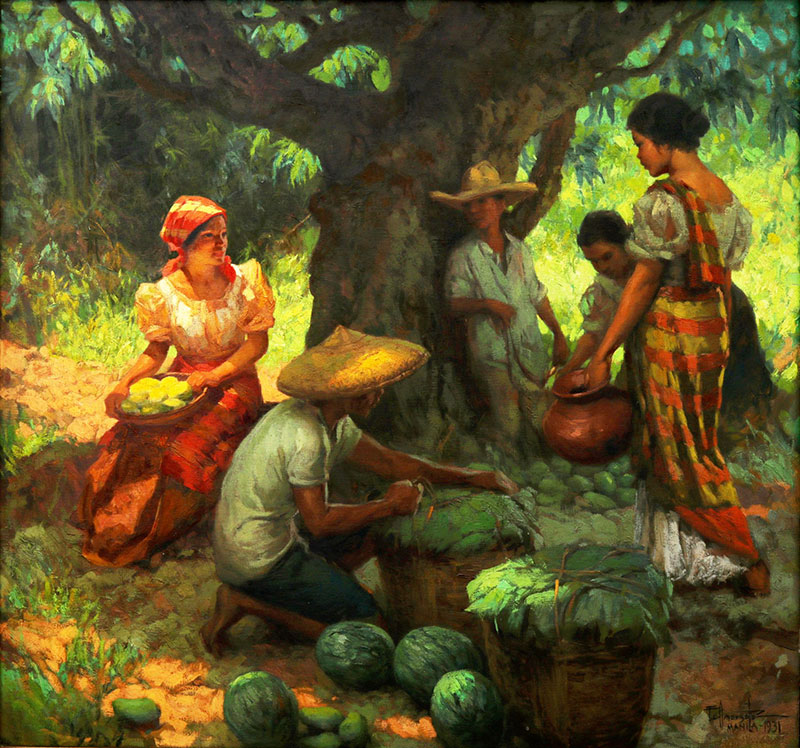Paintings with pedigrees at Leon Gallery auction: The Melian-Zobel and Ynchausti Amorsolos

MANILA, Philippines — I have three categories of art,” said a certain cosmetics zillionaire, as reported by society-bible Vanity Fair, “Oh, Oh my, and Oh my God.”
Paintings with pedigrees uniformly fall in the “Oh my God” category, primarily because such families rarely ever part with the gorgeous canvases on their walls. (That may all change very soon, as the recent Rockefeller auction demonstrated by raking in close to $1 billion.)
Various such works inhabit the upcoming Leon Gallery “Spectacular Mid-Year Auction,” all begging to move from one palatial home to another. (We’ll find out who writes their name on these beauties on Saturday, June 9 at the Eurovilla I showrooms on Legaspi Street, Legaspi Village, Makati at 2 p.m. onwards.)
The enchanting Amorsolo belonging to the Melian-Zobel, aka the Condes de Peracamps, is just one example. This lyrical painting once belonged to Don Antonio Melian, the third Count of Peracamps, and his wife Dona Margarita, born Zobel de Ayala.
Antonio Melian is most famous these days for being the man who built the “El Hogar” building which has become a sort of battleground for conservationists. El Hogar (which means “The Hearth” in Spanish) is said to have been a Taj Mahal-like present for his wife Margarita; certainly it was a lavish testimony to Melian’s success as the country’s first insurance man.

“Under the Mango Tree” by Fernando Amorsolo
Titled “Under the Mango Tree,” it is believed by another distinguished daughter, Sylvia Lazo — keeper of the flame of Fernando Cueto Amorsolo — to be the first such work with that theme. Painted in 1931, it features lush imagery and a rich impasto, fitting for the family of Amorsolo’s best patron. Margarita Zobel de Ayala was, after all, the sister of the Don Enrique who not only gave Amorsolo various commissions but also paid his way to study in the Royal Academy of the Fine Arts of San Fernando in Madrid.
The superb piece features the pantheon of seminal Amorsolo figures — the dalagang bukid (or country girl) with her head covered with a kerchief and a flat basket or bilao of mangoes on her lap; another shapely lass, an alampay scarf draped over her shoulder, carrying an earthenware banga (jar); two men in salakot hats, one tying a kaing (basket) of fruit, the other leaning against a sinewy tree.
Peracamps in Catalonia is in a rather windblown, craggy part of Spain made famous for making a certain General Van Halen victorious in battle and earning him a title from the King of Spain. The painting in question has been handed down to the various heirs of the house, including the 5th Conde, Leopoldo Melian Zobel married to Natividad Ugarte Aboitiz.

XAmorsolo’s “Ynchausti Rope Factory” (Later the Old Elizalde Building)
Another fabled family is the Ynchausti who have been in the country since the 1800s and according to society raconteur Augusto “Toto” Gonzalez were, in the 19th century, the biggest privately–held business conglomerate in ‘Las Islas Filipinas.’ “JJ Ynchausti y Compania was known worldwide for the export of sturdy Manila hemp (abaca cordage) and for the delicious rum of Destileria Tanduay. In 1898, Ynchausti y Cia was one of the biggest lenders to the government of General Emilio Aguinaldo. When the Americans eventually occupied the islands, their bean-counters identified the two biggest Philippine companies as Ynchausti y Cia and Tabacalera,” said Gonzalez.
The Amorsolo painting of one of the pillars of their fortune shows the “Ynchausti Rope Factory.” It was painted in 1926. “From the 1930s onwards,” Gonzalez notes, “Manuel de Ynchausti divested the family’s Philippine holdings to various entities like the Elizalde family and the Madrigal family to diversify the Ynchausti’s international interests, to fund the Basque cause of independence, and to support more humanitarian and church projects in the Philippines.”
The Ynchausti Rope Factory would morph into the “Old Elizalde Building” and would be featured in the Elizalde company magazine in 1936.

“Portrait of Don Pio Pedrosa (1944)” by Amorsolo
Don Pio Pedrosa, on the other hand, was the image of the man of “old-fashioned virtues.” Rising from the Budget Commission to become Finance Secretary, Chair of the Monetary Board and the President of the Philippine National Bank, Don Pio was the epitome of the devoted pre-war public servant. He also had impeccable taste and was among the first to collect a certain artist named Vicente Manansala.
Manansala’s “Pounding Rice” — more Edades and Botong than his now-famous transparent Cubism — is an allegory of life in these islands. Three women, like the Shakespearean witches, surround this ancient receptacle like a Scottish cauldron. Dressed in various Filipino tribal garb, they seem to represent Luzon, Visayas and Mindanao though they stand on a piece of land that appears to have been torn from the rest of the archipelago. The rice terraces loom in the distance and a black carabao, another symbol of the Filipino, is in the foreground. Like Amorsolo’s “Under the Mango Tree,” Manansala’s “Pounding Rice” at hand is perhaps the first of its kind, and is a theme that the master would return to through the years in various incarnations. This one is his most pristine and evocative as are so many works in the hands of the great Filipino families.



















